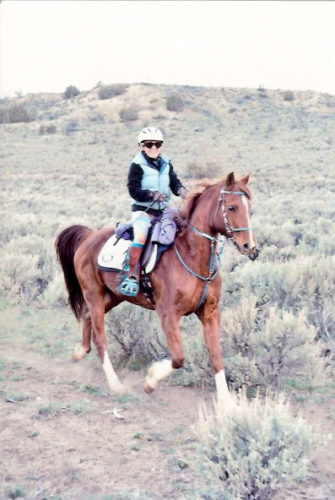Saddle Fit and Endurance Riding

Endurance riders (and horses) are the marathon athletes of the equestrian world. Obviously, long hours of preparation and training go into every event. Many endurance riders include dressage training as part of the curriculum to strengthen the horse’s back – in a properly adjusted and fitting saddle of course that allows the horse the necessary freedom to move at the shoulder and to engage his back properly. Just as important as comprehensive training however is, of course, the proper equipment.
It is one of the biggest challenges for the endurance rider to keep the horse sound and healthy over the course of the competition – one of the most grueling of these is the Western States 100 Mile 24-hour Tevis Cup Competition. As such, I have heard directly from the author of “Tevis – From the Back of my Horse” (Sharma Gaponoff) what the preparation and the competition entail. When in competition she trains three smaller rides/week (about 10 miles each) and one 50 mile ride/month.
Some horses can lose 100-200 pounds in a race of this length. The conditions are extreme – temperatures fluctuate between very hot during the day to almost freezing at night. The terrain is demanding and often dangerous. It is important to have a great support team, and the vet checks are rigorous to ensure the horses are sound enough to handle what lies ahead.
Funny enough, many European riders think that riders in North America suffer from the “American Loose Girth Syndrome”. A loose girth is not good, especially during the long hours of intense riding during endurance competition and training because the saddle will definitely be shifting which is very uncomfortable for the horse. A tighter girth gives the horse more support as well because the saddle stays where it belongs. Many riders believe that a tight girth is only for jumping, etc. and that when you are doing endurance competition, you don’t want the horse to feel as though he is constricted by the girth being too tight. You don’t need to squeeze all the air out of their lungs when the horses are girthed up, but definitely the saddles need to be snugly fastened and stay that way for the entire ride.
Without minimizing the necessity for a blacksmith on site because of potential shoeing issues, saddle fit is certainly the biggest problem due to the massive weight loss. A saddle that was fitting properly at the start will certainly show issues during the course of the ride given that the horse’s conformation will actually have changed within just 24 hours!
One of the best way to help the horse is to keep the saddle pad dry (change wet saddle pads). Imagine you were to walk in your shoes all day with moist socks – your skin would get soft and start to blister. Some riders get off their saddles during the ride and run beside their horse: this gives the horse less weight to carry at least over short distances. To counteract the effect of losing weight, most of the riders use cruppers and breast plates to ensure that the saddle stays in place, even for the up-and downhill portions of the ride. One of the best saddle designs ever developed is the McClellan army saddle, which was made for horses who were used in the military and had to be kept healthy in order to ensure survival of their riders; unfortunately it was discontinued in the 1920s, but its basic design is probably still the most ergonomically friendly for both horse and rider!
Saddle fit is critical even for shorter trail rides; indeed for any activity with your partner and friend – the horse! Now is the time to have your own saddle fit assessed before the competition season begins again in earnest, Call 800-225-2242 and ask to schedule your own 80 point diagnostic on-site evaluation!
